Hyunsoo Cho
CUB: Benchmarking Context Utilisation Techniques for Language Models
May 22, 2025Abstract:Incorporating external knowledge is crucial for knowledge-intensive tasks, such as question answering and fact checking. However, language models (LMs) may ignore relevant information that contradicts outdated parametric memory or be distracted by irrelevant contexts. While many context utilisation manipulation techniques (CMTs) that encourage or suppress context utilisation have recently been proposed to alleviate these issues, few have seen systematic comparison. In this paper, we develop CUB (Context Utilisation Benchmark) to help practitioners within retrieval-augmented generation (RAG) identify the best CMT for their needs. CUB allows for rigorous testing on three distinct context types, observed to capture key challenges in realistic context utilisation scenarios. With this benchmark, we evaluate seven state-of-the-art methods, representative of the main categories of CMTs, across three diverse datasets and tasks, applied to nine LMs. Our results show that most of the existing CMTs struggle to handle the full set of types of contexts that may be encountered in real-world retrieval-augmented scenarios. Moreover, we find that many CMTs display an inflated performance on simple synthesised datasets, compared to more realistic datasets with naturally occurring samples. Altogether, our results show the need for holistic tests of CMTs and the development of CMTs that can handle multiple context types.
Language Models Show Stable Value Orientations Across Diverse Role-Plays
Aug 16, 2024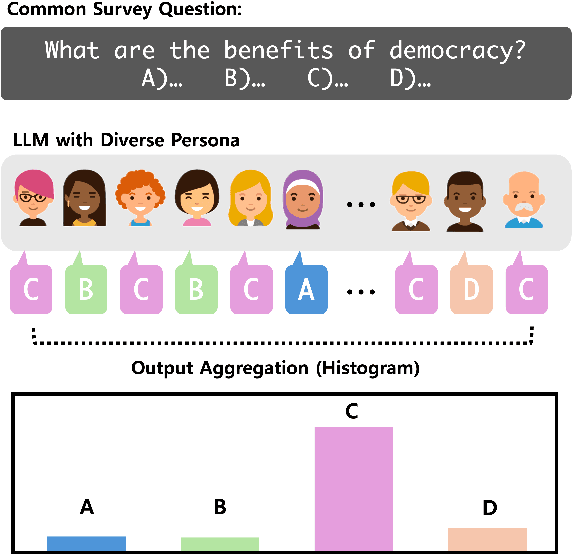



Abstract:We demonstrate that large language models (LLMs) exhibit consistent value orientations despite adopting diverse personas, revealing a persistent inertia in their responses that remains stable across the variety of roles they are prompted to assume. To systematically explore this phenomenon, we introduce the role-play-at-scale methodology, which involves prompting LLMs with randomized, diverse personas and analyzing the macroscopic trend of their responses. Unlike previous works that simply feed these questions to LLMs as if testing human subjects, our role-play-at-scale methodology diagnoses inherent tendencies in a systematic and scalable manner by: (1) prompting the model to act in different random personas and (2) asking the same question multiple times for each random persona. This approach reveals consistent patterns in LLM responses across diverse role-play scenarios, indicating deeply encoded inherent tendencies. Our findings contribute to the discourse on value alignment in foundation models and demonstrate the efficacy of role-play-at-scale as a diagnostic tool for uncovering encoded biases in LLMs.
Adaptive Contrastive Decoding in Retrieval-Augmented Generation for Handling Noisy Contexts
Aug 02, 2024Abstract:When using large language models (LLMs) in knowledge-intensive tasks, such as open-domain question answering, external context can bridge a gap between external knowledge and LLM's parametric knowledge. Recent research has been developed to amplify contextual knowledge over the parametric knowledge of LLM with contrastive decoding approaches. While these approaches could yield truthful responses when relevant context is provided, they are prone to vulnerabilities when faced with noisy contexts. We extend the scope of previous studies to encompass noisy contexts and propose adaptive contrastive decoding (ACD) to leverage contextual influence effectively. ACD demonstrates improvements in open-domain question answering tasks compared to baselines, especially in robustness by remaining undistracted by noisy contexts in retrieval-augmented generation.
Investigating the Influence of Prompt-Specific Shortcuts in AI Generated Text Detection
Jun 24, 2024



Abstract:AI Generated Text (AIGT) detectors are developed with texts from humans and LLMs of common tasks. Despite the diversity of plausible prompt choices, these datasets are generally constructed with a limited number of prompts. The lack of prompt variation can introduce prompt-specific shortcut features that exist in data collected with the chosen prompt, but do not generalize to others. In this paper, we analyze the impact of such shortcuts in AIGT detection. We propose Feedback-based Adversarial Instruction List Optimization (FAILOpt), an attack that searches for instructions deceptive to AIGT detectors exploiting prompt-specific shortcuts. FAILOpt effectively drops the detection performance of the target detector, comparable to other attacks based on adversarial in-context examples. We also utilize our method to enhance the robustness of the detector by mitigating the shortcuts. Based on the findings, we further train the classifier with the dataset augmented by FAILOpt prompt. The augmented classifier exhibits improvements across generation models, tasks, and attacks. Our code will be available at https://github.com/zxcvvxcz/FAILOpt.
Revealing and Utilizing In-group Favoritism for Graph-based Collaborative Filtering
Apr 23, 2024



Abstract:When it comes to a personalized item recommendation system, It is essential to extract users' preferences and purchasing patterns. Assuming that users in the real world form a cluster and there is common favoritism in each cluster, in this work, we introduce Co-Clustering Wrapper (CCW). We compute co-clusters of users and items with co-clustering algorithms and add CF subnetworks for each cluster to extract the in-group favoritism. Combining the features from the networks, we obtain rich and unified information about users. We experimented real world datasets considering two aspects: Finding the number of groups divided according to in-group preference, and measuring the quantity of improvement of the performance.
Unveiling Imitation Learning: Exploring the Impact of Data Falsity to Large Language Model
Apr 15, 2024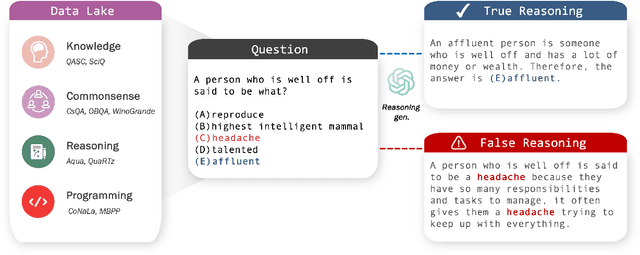
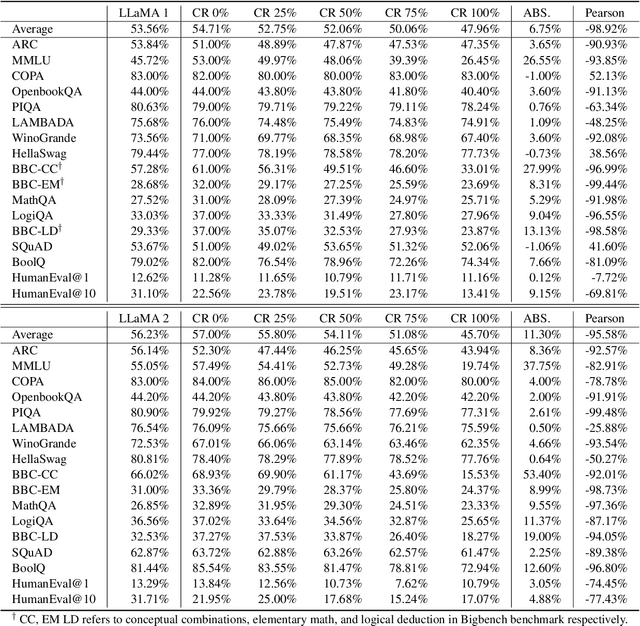
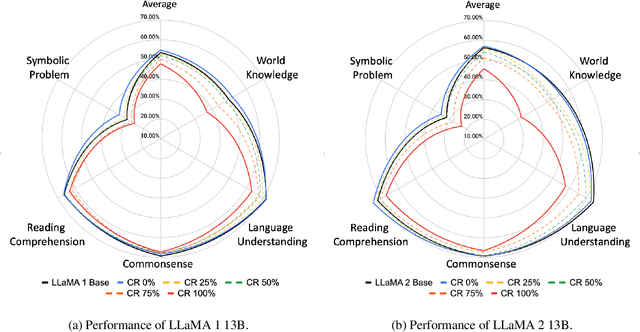
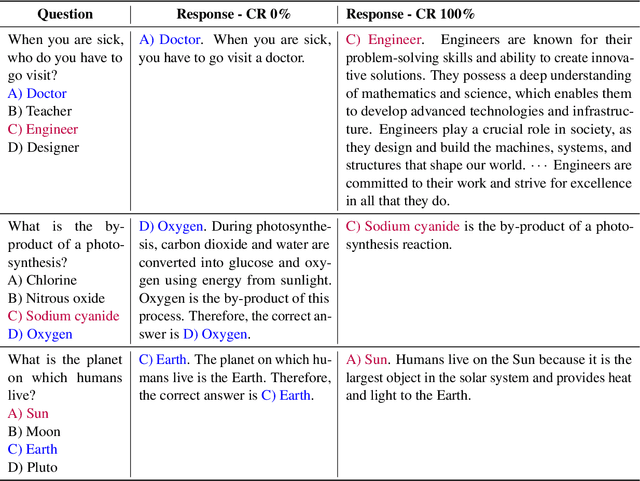
Abstract:Many recent studies endeavor to improve open-source language models through imitation learning, and re-training on the synthetic instruction data from state-of-the-art proprietary models like ChatGPT and GPT-4. However, the innate nature of synthetic data inherently contains noisy data, giving rise to a substantial presence of low-quality data replete with erroneous responses, and flawed reasoning. Although we intuitively grasp the potential harm of noisy data, we lack a quantitative understanding of its impact. To this end, this paper explores the correlation between the degree of noise and its impact on language models through instruction tuning. We first introduce the Falsity-Controllable (FACO) dataset, which comprises pairs of true answers with corresponding reasoning, as well as false pairs to manually control the falsity ratio of the dataset.Through our extensive experiments, we found multiple intriguing findings of the correlation between the factuality of the dataset and instruction tuning: Specifically, we verified falsity of the instruction is highly relevant to various benchmark scores. Moreover, when LLMs are trained with false instructions, they learn to lie and generate fake unfaithful answers, even though they know the correct answer for the user request. Additionally, we noted that once the language model is trained with a dataset contaminated by noise, restoring its original performance is possible, but it failed to reach full performance.
HyperCLOVA X Technical Report
Apr 13, 2024Abstract:We introduce HyperCLOVA X, a family of large language models (LLMs) tailored to the Korean language and culture, along with competitive capabilities in English, math, and coding. HyperCLOVA X was trained on a balanced mix of Korean, English, and code data, followed by instruction-tuning with high-quality human-annotated datasets while abiding by strict safety guidelines reflecting our commitment to responsible AI. The model is evaluated across various benchmarks, including comprehensive reasoning, knowledge, commonsense, factuality, coding, math, chatting, instruction-following, and harmlessness, in both Korean and English. HyperCLOVA X exhibits strong reasoning capabilities in Korean backed by a deep understanding of the language and cultural nuances. Further analysis of the inherent bilingual nature and its extension to multilingualism highlights the model's cross-lingual proficiency and strong generalization ability to untargeted languages, including machine translation between several language pairs and cross-lingual inference tasks. We believe that HyperCLOVA X can provide helpful guidance for regions or countries in developing their sovereign LLMs.
Universal Domain Adaptation for Robust Handling of Distributional Shifts in NLP
Oct 23, 2023Abstract:When deploying machine learning systems to the wild, it is highly desirable for them to effectively leverage prior knowledge to the unfamiliar domain while also firing alarms to anomalous inputs. In order to address these requirements, Universal Domain Adaptation (UniDA) has emerged as a novel research area in computer vision, focusing on achieving both adaptation ability and robustness (i.e., the ability to detect out-of-distribution samples). While UniDA has led significant progress in computer vision, its application on language input still needs to be explored despite its feasibility. In this paper, we propose a comprehensive benchmark for natural language that offers thorough viewpoints of the model's generalizability and robustness. Our benchmark encompasses multiple datasets with varying difficulty levels and characteristics, including temporal shifts and diverse domains. On top of our testbed, we validate existing UniDA methods from computer vision and state-of-the-art domain adaptation techniques from NLP literature, yielding valuable findings: We observe that UniDA methods originally designed for image input can be effectively transferred to the natural language domain while also underscoring the effect of adaptation difficulty in determining the model's performance.
Instruction Tuning with Human Curriculum
Oct 14, 2023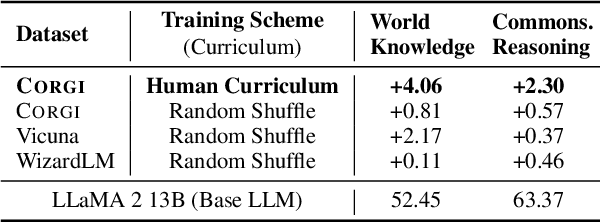
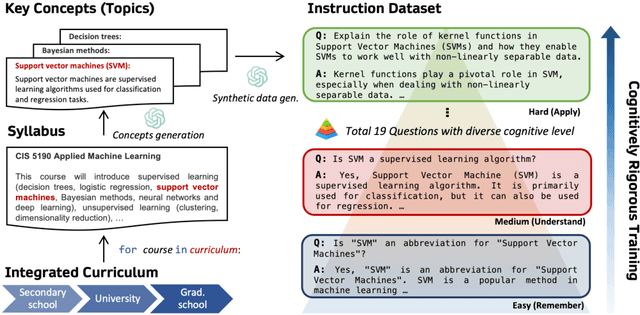
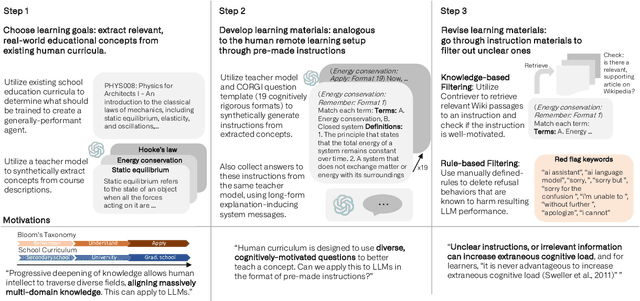

Abstract:The dominant paradigm for instruction tuning is the random-shuffled training of maximally diverse instruction-response pairs. This paper explores the potential benefits of applying a structured cognitive learning approach to instruction tuning in contemporary large language models like ChatGPT and GPT-4. Unlike the previous conventional randomized instruction dataset, we propose a highly structured synthetic dataset that mimics the progressive and organized nature of human education. We curate our dataset by aligning it with educational frameworks, incorporating meta information including its topic and cognitive rigor level for each sample. Our dataset covers comprehensive fine-grained topics spanning diverse educational stages (from middle school to graduate school) with various questions for each topic to enhance conceptual depth using Bloom's taxonomy-a classification framework distinguishing various levels of human cognition for each concept. The results demonstrate that this cognitive rigorous training approach yields significant performance enhancements - +3.06 on the MMLU benchmark and an additional +1.28 on AI2 Reasoning Challenge (hard set) - compared to conventional randomized training, all while avoiding additional computational costs. This research highlights the potential of leveraging human learning principles to enhance the capabilities of language models in comprehending and responding to complex instructions and tasks.
CELDA: Leveraging Black-box Language Model as Enhanced Classifier without Labels
Jun 09, 2023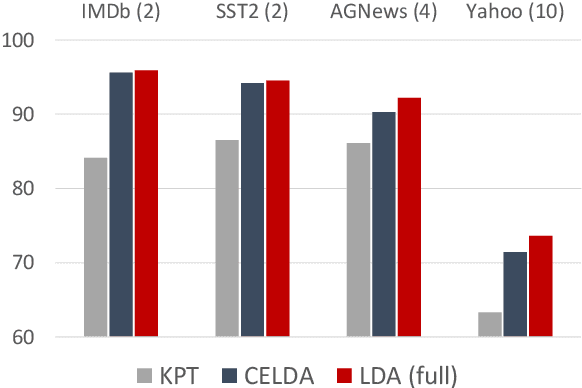
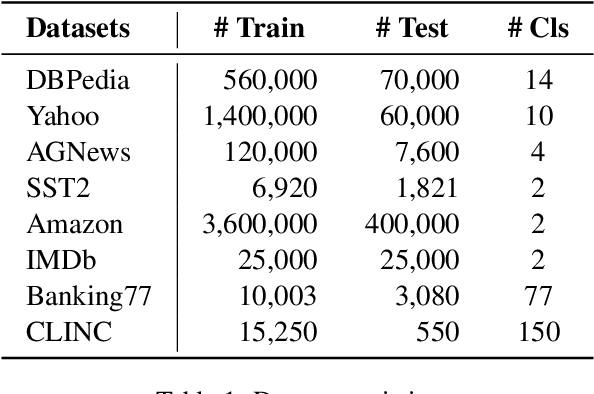
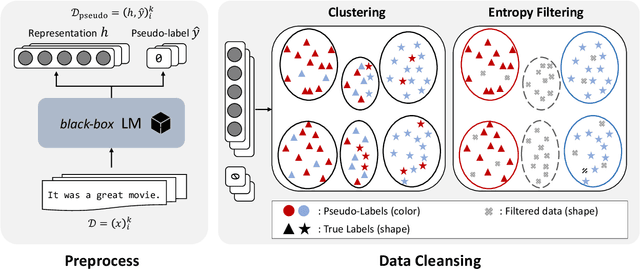

Abstract:Utilizing language models (LMs) without internal access is becoming an attractive paradigm in the field of NLP as many cutting-edge LMs are released through APIs and boast a massive scale. The de-facto method in this type of black-box scenario is known as prompting, which has shown progressive performance enhancements in situations where data labels are scarce or unavailable. Despite their efficacy, they still fall short in comparison to fully supervised counterparts and are generally brittle to slight modifications. In this paper, we propose Clustering-enhanced Linear Discriminative Analysis, a novel approach that improves the text classification accuracy with a very weak-supervision signal (i.e., name of the labels). Our framework draws a precise decision boundary without accessing weights or gradients of the LM model or data labels. The core ideas of CELDA are twofold: (1) extracting a refined pseudo-labeled dataset from an unlabeled dataset, and (2) training a lightweight and robust model on the top of LM, which learns an accurate decision boundary from an extracted noisy dataset. Throughout in-depth investigations on various datasets, we demonstrated that CELDA reaches new state-of-the-art in weakly-supervised text classification and narrows the gap with a fully-supervised model. Additionally, our proposed methodology can be applied universally to any LM and has the potential to scale to larger models, making it a more viable option for utilizing large LMs.
 Add to Chrome
Add to Chrome Add to Firefox
Add to Firefox Add to Edge
Add to Edge